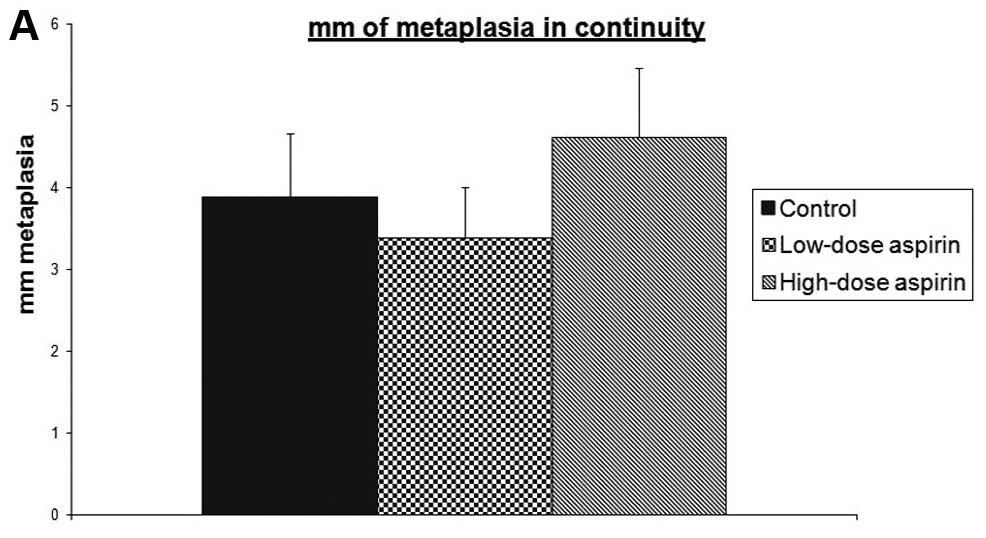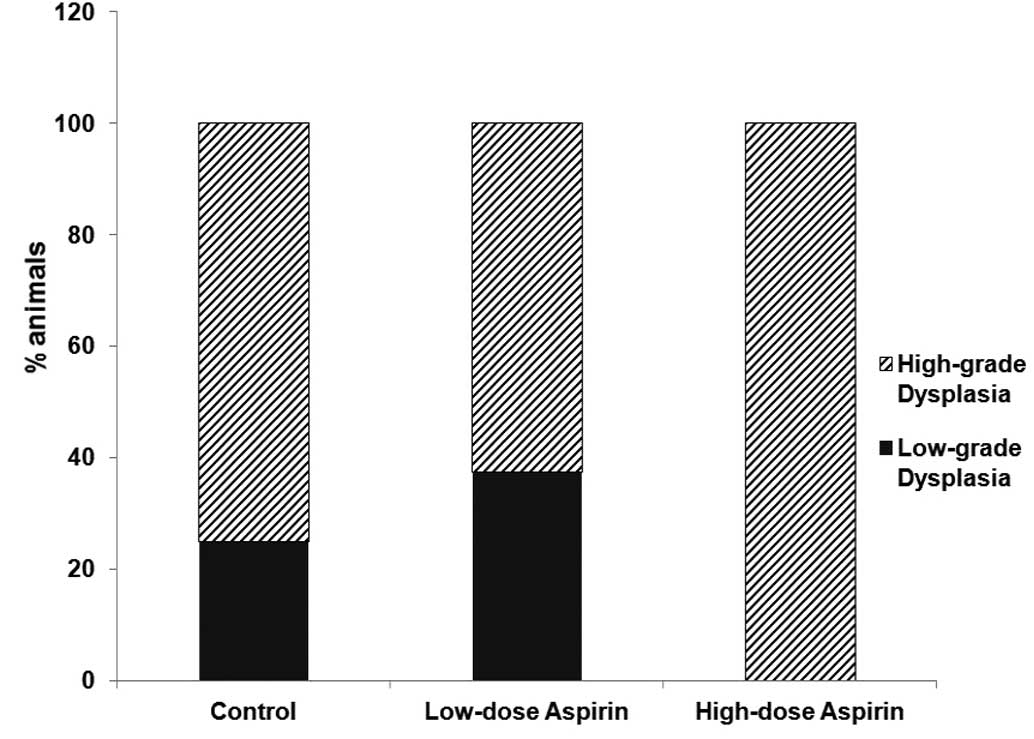|
1
|
Pera M, Manterola C, Vidal O and Grande L:
Epidemiology of esophageal adenocarcinoma. J Surg Oncol.
92:151–159. 2005. View Article : Google Scholar : PubMed/NCBI
|
|
2
|
Blot WJ, Devesa SS, Kneller RW and
Fraumeni JF Jr: Rising incidence of adenocarcinoma of the esophagus
and gastric cardia. JAMA. 265:1287–1289. 1991. View Article : Google Scholar : PubMed/NCBI
|
|
3
|
Devesa SS, Blot WJ and Fraumeni JF Jr:
Changing patterns in the incidence of esophageal and gastric
carcinoma in the United States. Cancer. 83:2049–2053. 1998.
View Article : Google Scholar : PubMed/NCBI
|
|
4
|
Mutoh M, Watanabe K, Kitamura T, Shoji Y,
Takahashi M, Kawamori T, Tani K, Kobayashi M, Maruyama T, Kobayashi
K, Ohuchida S, Sugimoto Y, Narumiya S, Sugimura T and Wakabayashi
K: Involvement of prostaglandin E receptor subtype EP4
in colon carcinogenesis. Cancer Res. 62:28–32. 2002.PubMed/NCBI
|
|
5
|
Husain SS, Szabo IL and Tamawski AS: NSAID
inhibition of GI cancer growth: clinical implications and molecular
mechanisms of action. Am J Gastroenterol. 97:542–553. 2002.
View Article : Google Scholar : PubMed/NCBI
|
|
6
|
Piazuelo E, Jimenez P and Lanas A: COX-2
inhibition in esophagitis, Barrett’s esophagus and esophageal
cancer. Curr Pharm Des. 9:2267–2280. 2003.
|
|
7
|
Al-Saeed A: Gastrointestinal and
cardiovascular risk of nonsteroidal anti-inflammatory drugs. Oman
Med. 26:385–391. 2011. View Article : Google Scholar : PubMed/NCBI
|
|
8
|
Patrignani P, Tacconelli S, Bruno A,
Sostres C and Lanas A: Managing the adverse effects of nonsteroidal
anti-inflammatory drugs. Expert Rev Clin Pharmacol. 4:605–621.
2011. View Article : Google Scholar : PubMed/NCBI
|
|
9
|
Hennekens CH: Update on aspirin in the
treatment and prevention of cardiovascular disease. Am Heart J.
137:S9–S13. 1999. View Article : Google Scholar : PubMed/NCBI
|
|
10
|
Dai Y and Ge J: Clinical use of aspirin in
treatment and prevention of cardiovascular disease. Thrombosis.
2012:2450372012.PubMed/NCBI
|
|
11
|
Piazuelo E, Cebrián C, Escartín A, Jiménez
P, Soteras F, Ortego J and Lanas A: Superoxide dismutase prevents
development of adenocarcinoma in a rat model of Barrett’s
esophagus. World J Gastroenterol. 11:7436–7443. 2005.PubMed/NCBI
|
|
12
|
Hindmarsh A, Belshaw N, Mehta S, Johnson
IT and Rhodes M: Can the rat be used as a valid model of human
esophageal adenocarcinoma? Dis Esophagus. 25:159–165. 2011.
View Article : Google Scholar : PubMed/NCBI
|
|
13
|
Su Y, Chen X, Klein M, Fang M, Wang S,
Yang CS and Goyal RK: Phenotype of columnar-lined esophagus in rats
with esophagogastroduodenal anastomosis: similarity to human
Barrett’s esophagus. Lab Invest. 84:753–765. 2004.PubMed/NCBI
|
|
14
|
Reddy BS, Rao CV, Rivenson A and Kelloff
G: Inhibitory effect of aspirin on azoxymethane-induced colon
carcinogenesis in F344 rats. Carcinogenesis. 14:1493–1497. 1993.
View Article : Google Scholar : PubMed/NCBI
|
|
15
|
Barnes CJ and Lee M: Chemoprevention of
spontaneous intestinal adenomas in the adenomatous polyposis coli
Min mouse model with aspirin. Gastroenterology. 114:873–877. 1998.
View Article : Google Scholar : PubMed/NCBI
|
|
16
|
Bousserouel S, Gosse F, Bouhadjar M, Soler
L, Marescaux J and Rau F: Long-term administration of aspirin
inhibits tumour formation and triggers anti-neoplastic molecular
changes in a pre-clinical model of colon carcinogenesis. Oncol Rep.
23:511–517. 2010.
|
|
17
|
Haggitt RC: Barrett’s esophagus,
dysplasia, and adenocarcinoma. Hum Pathol. 25:982–993. 1994.
|
|
18
|
Powell WS: Reversed-phase high-pressure
liquid chromatography of arachidonic acid metabolites formed by
cyclooxygenase and lipoxygenases. Anal Biochem. 148:59–69. 1985.
View Article : Google Scholar : PubMed/NCBI
|
|
19
|
Lanas AI, Arroyo MT, Esteva F, Cornudella
R, Hirschowitz BI and Sáinz R: Aspirin related gastrointestinal
bleeders have an exaggerated bleeding time response due to aspirin
use. Gut. 39:654–660. 1996. View Article : Google Scholar : PubMed/NCBI
|
|
20
|
Jang TJ, Min SK, Bae JD, Jung KH, Lee JI,
Kim JR and Ahn WS: Expression of cyclooxygenase 2, microsomal
prostaglandin E synthase 1, and EP receptors is increased in rat
oesophageal squamous cell dysplasia and Barrett’s metaplasia
induced by duodenal contents reflux. Gut. 53:27–33. 2004.PubMed/NCBI
|
|
21
|
Piazuelo E, Santander S, Cebrián C,
Jiménez P, Pastor C, García-González MA, Esteva F, Esquivias P,
Ortego J and Lanas A: Characterization of the prostaglandin E2
pathway in a rat model of esophageal adenocarcinoma. Curr Cancer
Drug Targets. 12:132–143. 2012. View Article : Google Scholar : PubMed/NCBI
|
|
22
|
Wilson KT, Fu S, Ramanujam KS and Meltzer
SJ: Increased expression of inducible nitric oxide synthase and
cyclooxygenase-2 in Barrett’s esophagus and associated
adenocarcinomas. Cancer Res. 58:2929–2934. 1998.
|
|
23
|
Jimenez P, Piazuelo E, Cebrian C, Ortego
J, Strunk M, García-Gonzalez MA, Santander S, Alcedo J and Lanas A:
Prostaglandin EP2 receptor expression is increased in Barrett’s
oesophagus and oesophageal adenocarcinoma. Aliment Pharmacol Ther.
31:440–451. 2010.
|
|
24
|
Esquivias P, Morandeira A, Escartín A,
Cebrián C, Santander S, Esteva F, García-González MA, Ortego J,
Lanas A and Piazuelo E: Indomethacin but not a selective
cyclooxygenase-2 inhibitor inhibits esophageal adenocarcinogenesis
in rats. World J Gastroenterol. 18:4866–4874. 2012. View Article : Google Scholar : PubMed/NCBI
|
|
25
|
Buttar NS, Wang KK, Leontovich O, Westcott
JY, Pacifico RJ, Anderson MA, Krishnadath KK, Lutzke LS and Burgart
LJ: Chemoprevention of esophageal adenocarcinoma by COX-2
inhibitors in an animal model of Barrett’s esophagus.
Gastroenterology. 122:1101–1112. 2002.PubMed/NCBI
|
|
26
|
Oyama K, Fujimura T, Ninomiya I, Miyashita
T, Kinami S, Fushida S, Ohta T and Koichi M: A COX-2 inhibitor
prevents the esophageal inflammation-metaplasia-adenocarcinoma
sequence in rats. Carcinogenesis. 26:565–570. 2005. View Article : Google Scholar : PubMed/NCBI
|
|
27
|
Chen X, Wang S, Wu N, Sood S, Wang P, Jin
Z, Beer DG, Giordano TJ, Lin Y, Shih WC, Lubet RA and Yang CS:
Overexpression of 5-lipoxygenase in rat and human esophageal
adenocarcinoma and inhibitory effects of zileuton and celecoxib on
carcinogenesis. Clin Cancer Res. 10:6703–6709. 2004. View Article : Google Scholar : PubMed/NCBI
|
|
28
|
Patrono C and Rocca B: Aspirin: promise
and resistance in the new millennium. Arterioscler Thromb Vasc
Biol. 28:s25–s32. 2008. View Article : Google Scholar : PubMed/NCBI
|
|
29
|
Claria J and Serhan CN: Aspirin triggers
previously undescribed bioactive eicosanoids by human endothelial
cell-leukocyte interactions. Proc Natl Acad Sci USA. 92:9475–9479.
1995. View Article : Google Scholar : PubMed/NCBI
|
|
30
|
Morris T, Stables M, Hobbs A, de Souza P,
Colville-Nash P, Warner T, Newson J, Bellingan G and Gilroy DW:
Effects of low-dose aspirin on acute inflammatory responses in
humans. J Immunol. 183:2089–2096. 2009. View Article : Google Scholar : PubMed/NCBI
|
|
31
|
Zhou XY, Li YS, Wu P, Wang HM, Cai ZY, Xu
FY and Ye DY: Lipoxin A4 inhibited hepatocyte growth
factor-induced invasion of human hepatoma cells. Hepatol Res.
39:921–930. 2009.PubMed/NCBI
|
|
32
|
Chen Y, Hao H, He S, Cai L, Li Y, Hu S, Ye
D, Hoidal J, Wu P and Chen X: Lipoxin A4 and its
analogue suppress the tumor growth of transplanted H22 in mice: the
role of antiangiogenesis. Mol Cancer Ther. 9:2164–2174.
2010.PubMed/NCBI
|
|
33
|
Dovizio M, Tacconelli S, Sostres C,
Ricciotti E and Patrignani P: Mechanistic and pharmacological
issues of aspirin as an anticancer agent. Pharmaceuticals.
5:1346–1371. 2012. View Article : Google Scholar : PubMed/NCBI
|
|
34
|
Sample D, Wargovich M, Fischer SM, Inamdar
N, Schwartz P, Wang X, Do KA and Sinicrope FA: A dose-finding study
of aspirin for chemoprevention utilizing rectal mucosal
prostaglandin E2 levels as a biomarker. Cancer Epidemiol
Biomarkers Prev. 11:275–279. 2002.PubMed/NCBI
|
|
35
|
Triadafilopoulos G, Kaur B, Sood S,
Traxler B, Levine D and Weston A: The effects of esomeprazole
combined with aspirin or rofecoxib on prostaglandin E2
production in patients with Barrett’s oesophagus. Aliment Pharmacol
Ther. 23:997–1005. 2006. View Article : Google Scholar : PubMed/NCBI
|
|
36
|
Falk GW, Buttar NS, Foster NR, Ziegler KL,
Demars CJ, Romero Y, Marcon NE, Schnell T, Corley DA, Sharma P,
Cruz-Correa MR, Hur C, Fleischer DE, Chak A, Devault KR, Weinberg
DS, Della’Zanna G, Richmond E, Smyrk TC, Mandrekar SJ and Limburg
PJ; Cancer Prevention Network. A combination of esomeprazole and
aspirin reduces tissue concentrations of prostaglandin
E2in patients with Barrett’s esophagus.
Gastroenterology. 143:917–926.e1. 2012. View Article : Google Scholar : PubMed/NCBI
|
|
37
|
Chiang N, Bermudez EA, Ridker PM, Hurwitz
S and Serhan CN: Aspirin triggers antiinflammatory 15-epi-lipoxin
A4 and inhibits thromboxane in a randomized human trial.
Proc Natl Acad Sci USA. 101:15178–15183. 2004. View Article : Google Scholar : PubMed/NCBI
|
|
38
|
Souza MH, de Lima OM Jr, Zamuner SR,
Fiorucci S and Wallace JL: Gastritis increases resistance to
aspirin-induced mucosal injury via COX-2-mediated lipoxin
synthesis. Am J Physiol Gastrointest Liver Physiol. 285:G54–G61.
2003. View Article : Google Scholar : PubMed/NCBI
|
|
39
|
Fiorucci S, de Lima OM Jr, Mencarelli A,
Palazzetti B, Distrutti E, McKnight W, Dicay M, Ma L, Romano M,
Morelli A and Wallace JL: Cyclooxygenase-2-derived lipoxin
A4 increases gastric resistance to aspirin-induced
damage. Gastroenterology. 123:1598–1606. 2002.PubMed/NCBI
|
|
40
|
Pawlik M, Pajdo R, Kwiecien S,
Ptak-Belowska A, Sliwowski Z, Mazurkiewicz-Janik M, Konturek SJ,
Pawlik WW and Brzozowski T: Nitric oxide (NO)-releasing aspirin
exhibits a potent esophagoprotection in experimental model of acute
reflux esophagitis. Role of nitric oxide and proinflammatory
cytokines. J Physiol Pharmacol. 62:75–86. 2011.
|
|
41
|
Rizvi S, Demars CJ, Comba A, Gainullin VG,
Rizvi Z, Almada LL, Wang K, Lomberk G, Fernández-Zapico ME and
Buttar NS: Combinatorial chemoprevention reveals a novel
smoothened-independent role of GLI1 in esophageal carcinogenesis.
Cancer Res. 70:6787–6796. 2010. View Article : Google Scholar : PubMed/NCBI
|
|
42
|
Sugimoto M, Nishino M, Kodaira C, Yamade
M, Ikuma M, Tanaka T, Sugimura H, Hishida A and Furuta T:
Esophageal mucosal injury with low-dose aspirin and its prevention
by rabeprazole. J Clin Pharmacol. 50:320–330. 2010. View Article : Google Scholar : PubMed/NCBI
|
|
43
|
Kawai T, Watanabe M and Yamashina A:
Impact of upper gastrointestinal lesions in patients on low-dose
aspirin therapy: preliminary study. J Gastroenterol Hepatol.
25(Suppl 1): S23–S30. 2010. View Article : Google Scholar : PubMed/NCBI
|
|
44
|
Lanas A, Jiménez P, Ferrández A, Escartín
A, Arenas J, Esteva F and Ortego J: Selective COX-2 inhibition is
associated with decreased mucosal damage induced by acid and pepsin
in rabbit esophagitis. Inflammation. 27:21–29. 2003. View Article : Google Scholar : PubMed/NCBI
|
|
45
|
Zhang DH, Zhou LY, Dong XY, Cui RL, Xue Y
and Lin SR: Factors influencing intercellular spaces in the rat
esophageal epithelium. World J Gastroenterol. 16:1063–1069. 2010.
View Article : Google Scholar : PubMed/NCBI
|
|
46
|
Pohle T, Brzozowski T, Becker JC, Van der
Voort IR, Markmann A, Konturek SJ, Moniczewski A, Domschke W and
Konturek JW: Role of reactive oxygen metabolites in aspirin-induced
gastric damage in humans: gastroprotection by vitamin C. Aliment
Pharmacol Ther. 15:677–687. 2001. View Article : Google Scholar : PubMed/NCBI
|
|
47
|
Raza H, John A and Benedict S:
Acetylsalicylic acid-induced oxidative stress, cell cycle arrest,
apoptosis and mitochondrial dysfunction in human hepatoma HepG2
cells. Eur J Pharmacol. 668:15–24. 2011. View Article : Google Scholar
|














